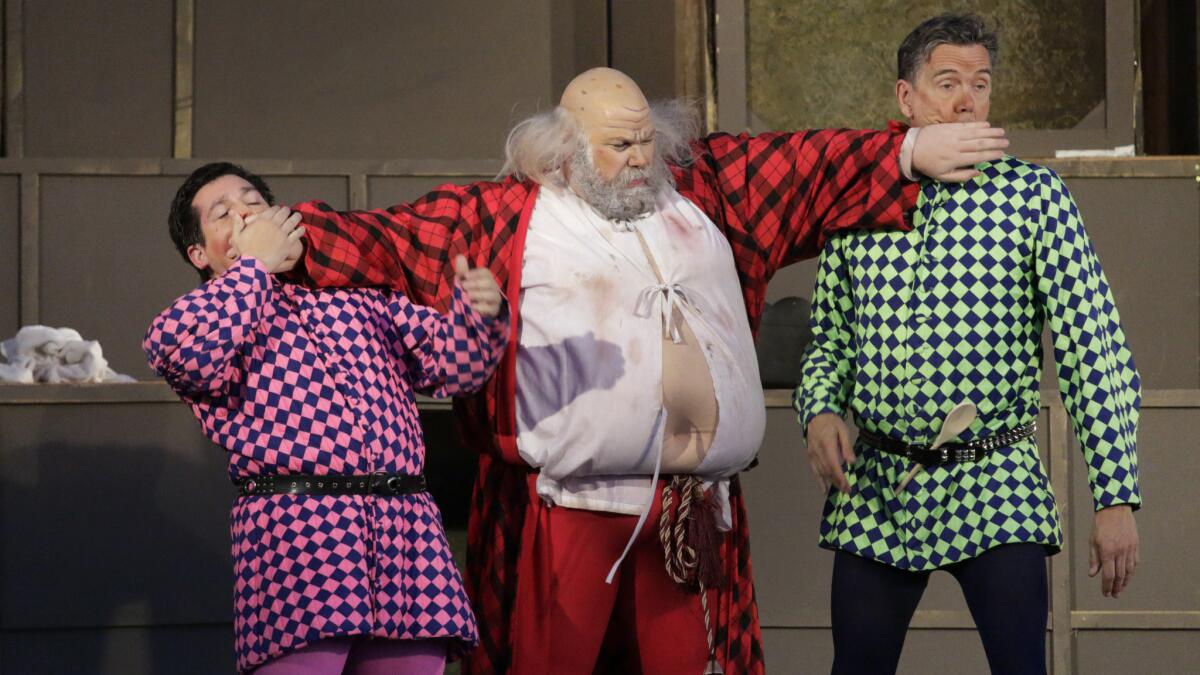Pacific Opera Project’s Forest Lawn ‘Falstaff’ has an offbeat charm

Kyle Patterson (Bardolfo), from left, Zeffin Quinn Hollis (John Falstaff) and Phil Meyer (Pistola) in Pacific Opera Projects’ “Falstaff.”
- Share via
The drive, Sunday, as the sun was setting, was operatic. The hill was steep. A blinding sun made it impossible to see the road ahead. On the sides were well-tended graves with fresh flowers. A few mourners lingered. At the top was the Museum Plaza of Forest Lawn, the site of Pacific Opera Project’s latest and characteristically out-of-character project.
It might seem as though there is already more than enough death in opera to rub it in by choosing a cemetery for a site-specific production.
But “POP is Fun,” so the scrappy, happy-go-lucky company’s motto maintains. POP has done its share of tragedies over the last four years (it’s in the opera racket, after all), but with a commitment to enjoyment and cheek. And what could be cheekier than Verdi’s “Falstaff” at Forest Lawn? The composer’s last opera is his only one in which death does not in any way threaten (the one other Verdi comedy, the early and rarely mounted “Un Giorno di Regno,” has a character who needs to escape a duel).
SIGN UP for the free Essential Arts & Culture newsletter >>
Actually, Forest Lawn was not such an inappropriate setting. The Museum Plaza does not overlook tombstones but the spectacular L.A. Basin. Other than a large illuminated cross and few pieces of comfortingly banal statuary, this might be a lookout in Griffith Park, with easier parking.
The real cheek here is, in fact, the challenge of ad hoc opera addressing one of the wisest, most humane, most meticulous works of the lyric stage. “Falstaff” can occupy a lifetime search for its essence, as Carlo Maria Giulini demonstrated when he conducted it in the early ‘80s with the Los Angeles Philharmonic.
POP’s approach is populist. Its frequent venue is the agreeably funky and intimate Highland Park Ebell Club. The style is informal. Although there are $25 general admission tickets, the most popular way to attend is to get a table for two or four (which includes, for only a few dollars more per person, a bottle of wine and the kind of snacks you promise yourself you won’t touch, but do).
Singers are young professionals. The orchestra is a chamber group smartly conducted by one of the company’s founders, Stephen Karr (also responsible for witty supertitles). The stagings by the other founder, Josh Shaw, can get wacky but remain respectful of the music. Singers make in-your-face contact with the audience. Virtual reality should be so lucky.
All that was true at Forest Lawn. Uptightness was not encouraged. Take pictures if you like and post them wherever. Resourceful as ever, POP even managed to get Forest Lawn to go along with serving wine. But the challenges of “Falstaff” are overwhelming, and the al fresco setting, however pretty and pleasant on a summer eve, was not ideal acoustically.
A 15-piece orchestra relying on an arresting arrangement of Verdi’s dazzling score was but a faint sound in the background. Winds and brass projected best, sounding like something that would have been heard on an Edison cylinder from the dawn of the recording age.
The set looked (I think intentionally) slapdash. Costumes had a harlequin theme, requiring singers to make an extra effort not to seem foolish. “Falstaff” is not a funky opera. A lot was lost.
But something important was gained. The secret to POP’s success is the faith it puts in singers. They have no crutches, no place to hide physically or vocally. You become invested in them as much, if not more, for whom they are than for the characters they are supposed to be.
That was particularly true for Zeffin Quinn Hollis. Falstaff is supposed to be gross, but a grubby, fat body suit and clown’s hair required extra effort to seem sympathetic.
The baritone, who is perhaps a little more seasoned a singer than normal for POP, went a step further and proved lovably slapstick. If he could sound gruff, he had to compensate for the outdoors. Without the orchestra’s interaction, his monologues about drink or self-esteem missed a key ingredient. Still, you never doubted that he was Verdi’s Falstaff.
Elaborate ensemble numbers suffered most, but there was plenty of characterful, winning singing from Rebecca Sjöwall (Alice Ford) and Jessica Mirshak (Meg), who merrily fend off Falstaff’s swaggering advances. Daniel Scofield proved a properly menacing and properly repentant Ford. Sharmay Musacchio (Mistress Quickly), Kyle Patterson (Bardolfo), Phil Meyer (Pistola) and Clay Hilley (Caius) deftly handled funny business vocally and physically.
The lovers, Nannetta and Fenton, were especially impressive. The young soprano Annie Sherman, starting to be seen around town, is a perky sensation. Nadav Hart, a pre-med student at UCLA, has a sweetly lyric tenor that could allow him to reinvent bedside manner.
Much is saved for the final scene in woods. With inventive costumes and lighting, the staging became more lavish and downright magical, once the chorus and child extras made their lovely entrance weaving through the tables. Everything felt right.
“Falstaff” repeats Saturday and Sunday night.
Twitter: @markswed
------------
‘Falstaff’
Where: Forest Lawn Museum Plaza, Glendale
When: 7:00 p.m. Sat. and Sun.
Cost: $25, general admission; tables for two $65-$80; tables for four, $120-$150
Info: (323) 739-6122, www.pacificoperaproject.com
More to Read
The biggest entertainment stories
Get our big stories about Hollywood, film, television, music, arts, culture and more right in your inbox as soon as they publish.
You may occasionally receive promotional content from the Los Angeles Times.











